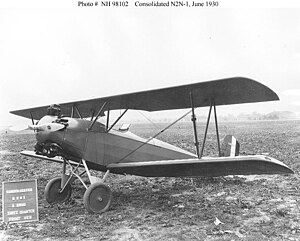13th School Group
| 13th School Group | |
|---|---|
 Photo of a Consolidated N2Y trainer. The 13th School Group flew the Army model of this aircraft, the PT-3A at March Field | |
| Active | 1927–1931 |
| Country | |
| Branch | |
| Type | Command and Control |
| Role | Flying Training |
| Commanders | |
| Notable commanders |
|
The 13th School Group was a unit of the United States Army Air Corps. It was last assigned to the 24th School Wing, and was demobilized on 30 April 1931 at March Field, California. The unit was an early United States Army Air Corps flying training group, and the first major unit assigned to March Field after its re-opening in 1927.
History
[edit]During World War I, March Field was a major primary pilot training base for the Air Service,[1] with its graduates being sent to advanced training schools before being deployed to the American Expeditionary Force in France. The school was closed after the armistice in February 1919.
In July 1919, Congress authorized resumption of enlistment of flying cadets on a limited basis, and the school at March Field was re-opened which offered a combined ground school and primary flight training using surplus Curtiss JN-4 Jennies. A shortage of money and failure of the training program to become as large as planned, prompted the closing of the primary school at March Field in 1921, and March became a storage depot. In 1922 it was decided to centralize all flying training in San Antonio, Texas.[2][3]
The decision by the Coolidge Administration in 1926 to expand the Air Corps found the facilities in San Antonio insufficient to accommodate the expanded number of cadets entering primary training. As a result, March Field was re-opened as a primary pilot training school in July 1927,[3] and the 13th School Group was designated to perform duties as the headquarters for the new Air Corps Primary Flying School.[4] Flight training was conducted in Consolidated PT-1 and PT-3s, which had taken over from the Curtiss Jennies. There were three school squadrons assigned, along with support squadrons.
Even before the school at March opened, it was known it was a temporary unit, as plans were ongoing to expand the facilities in San Antonio. With the opening of Randolph Field in 1931, the primary pilot training at March ended in April 1931 and March Field became the home of the new 1st Bombardment Wing.[3][4]
The group was activated again in 1943, but Standard military units, based on relatively inflexible tables of organization were proving not well adapted to the training mission. Accordingly, a more functional system was adopted in which each base was organized into a separate numbered unit.[5] The 13th Technical School Group was disbanded a year later when all units at Chanute Field were replaced by the 3502d Army Air Forces Base Unit.[6]
Lineage
[edit]- Constituted as the 13th Group (School) on 6 February 1923
- Redesignated 8 March 1929 as 13th School Group
- Activated on 31 July 1927
- Disbanded on 30 April 1931[4]
- Reconstituted and redesignated 13th Technical School Group
Assignments
[edit]- 24th School Wing, 8 July 1927 – 30 April 1931[4]
- Central Technical Training Command, 28 February 1943 – 30 April 1944
Components
[edit]- Flying Training Squadrons
- 47th School Squadron, 31 July 1927 – 30 April 1931
- 53d School Squadron, 31 July 1927 – 30 April 1931
- 54th School Squadron, 31 July 1927 – 30 April 1931 [4]
- Support Squadrons
- 69th Service Squadron, 31 July 1927 – 30 April 1931
- 70th Service Squadron, 31 July 1927 – 30 April 1931
- 23d Photo Section, 31 July 1927 – 30 April 1931 [4]
Stations
[edit]- March Field, California, 31 July 1927 – 30 April 1931[4]
- Chanute Field. Illinois, 28 February 1943 – 30 April 1944
See also
[edit]- World War I training fields of the Air Service, United States Army
References
[edit]Notes
[edit]Bibliography
[edit]![]() This article incorporates public domain material from the Air Force Historical Research Agency
This article incorporates public domain material from the Air Force Historical Research Agency
- Clay, Steven E. (2011). US Army Order of Battle 1919–1941 (PDF). Vol. 3 The Services: Air Service, Engineers, and Special Troops 1919–1941. Fort Leavenworth, KS: Combat Studies Institute Press. ISBN 978-0-98419-014-0. LCCN 2010022326. OCLC 637712205. Archived from the original (PDF) on 27 September 2013. Retrieved 16 October 2012.
- Goss, William A (1955). "The Organization and its Responsibilities, Chapter 2 The AAF". In Craven, Wesley F; Cate, James L (eds.). The Army Air Forces in World War II. Vol. VI, Men & Planes. Chicago, Illinois: University of Chicago Press. LCCN 48003657. OCLC 704158.
- Manning, Thomas A. (2005), History of Air Education and Training Command, 1942–2002. Office of History and Research, Headquarters, AETC, Randolph AFB, Texas OCLC 71006954, 29991467
- Maurer, Maurer (1987). Aviation in the U.S. Army, 1919–1939 (PDF). Washington, DC: Office of Air Force History, United States Air Force. ISBN 0-912799-38-2. LCCN 87012257. OCLC 15661556. Retrieved 20 July 2013.
- Mueller, Robert (1989). Air Force Bases, Vol. I, Active Air Force Bases Within the United States of America on 17 September 1982 (PDF). Washington, DC: Office of Air Force History. ISBN 0-912799-53-6.
- Order of Battle of the United States Land Forces in the First World War (PDF). Vol. 3, Part 2 Zone of the Interior: Territorial Departments, Tactical Divisions Organized in 1918, Posts, Camps and Stations (Reprint ed.). Washington, DC: Center of Military History. 1988 [1949]. Archived from the original (PDF) on 8 January 2021. Retrieved 1 November 2015.
